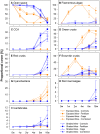In-Situ Effects of Simulated Overfishing and Eutrophication on Benthic Coral Reef Algae Growth, Succession, and Composition in the Central Red Sea
- PMID: 23840570
- PMCID: PMC3686771
- DOI: 10.1371/journal.pone.0066992
In-Situ Effects of Simulated Overfishing and Eutrophication on Benthic Coral Reef Algae Growth, Succession, and Composition in the Central Red Sea
Abstract
Overfishing and land-derived eutrophication are major local threats to coral reefs and may affect benthic communities, moving them from coral dominated reefs to algal dominated ones. The Central Red Sea is a highly under-investigated area, where healthy coral reefs are contending against intense coastal development. This in-situ study investigated both the independent and combined effects of manipulated inorganic nutrient enrichment (simulation of eutrophication) and herbivore exclosure (simulation of overfishing) on benthic algae development. Light-exposed and shaded terracotta tiles were positioned at an offshore patch reef close to Thuwal, Saudi Arabia and sampled over a period of 4 months. Findings revealed that nutrient enrichment alone affected neither algal dry mass nor algae-derived C or N production. In contrast, herbivore exclusion significantly increased algal dry mass up to 300-fold, and in conjunction with nutrient enrichment, this total increased to 500-fold. Though the increase in dry mass led to a 7 and 8-fold increase in organic C and N content, respectively, the algal C/N ratio (18±1) was significantly lowered in the combined treatment relative to controls (26±2). Furthermore, exclusion of herbivores significantly increased the relative abundance of filamentous algae on the light-exposed tiles and reduced crustose coralline algae and non-coralline red crusts on the shaded tiles. The combination of the herbivore exclusion and nutrient enrichment treatments pronounced these effects. The results of our study suggest that herbivore reduction, particularly when coupled with nutrient enrichment, favors non-calcifying, filamentous algae growth with high biomass production, which thoroughly outcompetes the encrusting (calcifying) algae that dominates in undisturbed conditions. These results suggest that the healthy reefs of the Central Red Sea may experience rapid shifts in benthic community composition with ensuing effects for biogeochemical cycles if anthropogenic impacts, particularly overfishing, are not controlled.
Conflict of interest statement
Figures





References
-
- Burke LM, Reytar K, Spalding M, Perry A (2011) Reefs at Risk Revisited. Washington, DC: World Resources Institute.
-
- Selman M, Greenhalgh S, Diaz R, Sugg Z (2008) Eutrophication and hypoxia in coastal areas: a global assessment of the state of knowledge. World Resources Institute. Washington, DC.
-
- Wild C, Hoegh-Guldberg O, Naumann MS, Colombo-Pallotta MF, Ateweberhan M, et al. (2011) Climate change impedes scleractinian corals as primary reef ecosystem engineers. Mar Freshw Res 62: 205–215.
-
- Koop K, Booth D, Broadbent A, Brodie J, Bucher D, et al. (2001) ENCORE: the effect of nutrient enrichment on coral reefs. Synthesis of results and conclusions. Mar Pollut Bull 42: 91–120. - PubMed
Publication types
MeSH terms
Substances
LinkOut - more resources
Full Text Sources
Other Literature Sources

